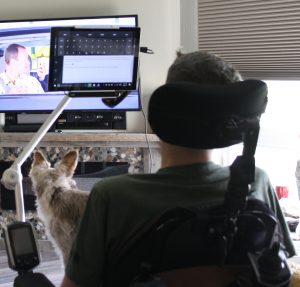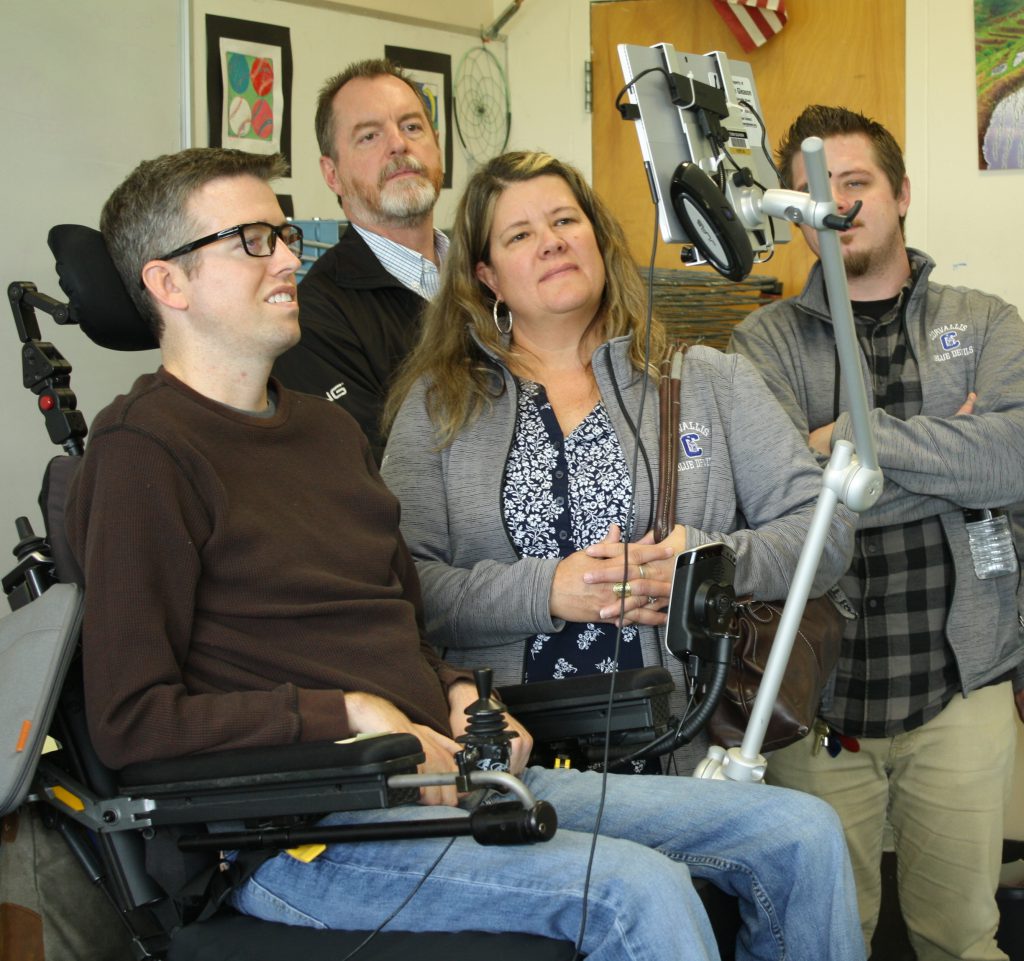By Scott Thomas
MonTECH
Four years ago, in my first months of using an eye-operated computer to communicate, I was conversing with my parents in a crowded restaurant. During our visit, I unintentionally played aloud bathroom instructions for my care assistant. Naturally, the decibel level in the restaurant decreased in direct correlation with the inappropriate, unfit-for-public-consumption quality of the instructions. My mother, wearing an expression of shock, reached over and turned off the computer. I sat frozen, paralyzed not from my condition, but from my own horror. Shortly after, we had a good laugh. This memory serves as a humorous and poignant reminder that the use of a computer to communicate can be intimidating, anxiety-provoking, and discouraging. But without it, I would have no voice.

My communication system is an example of augmentative and alternative communication (AAC), which supplements or replaces speech for those with impaired ability to communicate. AAC can be high tech (like my system) or low tech. The American Speech-Language-Hearing Association estimates over two million people use AAC; people with multiple sclerosis, cerebral palsy, ALS, Autism, brain injury, stroke, and developmental disability, to name a few.
While AAC is challenging, there is no doubt it improves lives. That is why former MonTECH Clinical Coordinator Julie Doerner and I, in collaboration with Julie’s graduate class of speech-language pathology (SLP) students, created an AAC Etiquette Guide. AAC developers and SLPs assess every AAC user’s needs on a case-by-case basis. When you encounter a person using AAC to communicate, you should use the same individualized approach. The aim of this Guide is not to advise how to communicate with every AAC user; rather, use it to serve as a thoughtful starting point for a more enjoyable interaction.
- Be patient and the rest will fall into place.
- Be flexible, mindful that technology is imperfect and doesn’t always work properly.
- Communicate with the person not the device. Display your usual eye contact, body language, and speech.
- Respect screen privacy, unless you’re invited to look. Think of an AAC device like you would a non-AAC-user’s smartphone screen. Many use their devices for things other than communication, like texting, email, banking, etc.
- Don’t assume lack of intelligence and limit topics of discussion.
- Normalize the interaction. Equipped with your knowledge of AAC etiquette you can have confidence in your approach. There is nothing that will make a user more comfortable than if you are comfortable.
- Check for understanding. AAC often does not accurately portray what the user intends to communicate, for reasons such as lack of ability to display range of tone and emotion. Also, transfer of thought to writing is more difficult than thought to natural speech. When you don’t understand what the user is trying to communicate, say so, recap what you do understand, then ask for further explanation.
- Ask one question or offer one topic for discussion at a time.
- As is the case with all assistive technologies and assistive equipment, don’t touch without asking first. Unless there is a good reason for touching, it’s best to avoid asking altogether. Users and those who assist them spend a great deal of time adjusting equipment so that it is efficient and comfortable.
- Be sure the user is done speaking before engaging in a separate conversation or walking away. It can be discouraging to not have the opportunity to share after having made the effort to type a response.
Ask the user if you wish to learn about his specific etiquette preferences. Although preferences might differ, generally you can have confidence in the following: be patient, be mindful of the limits of technology, and normalize the situation.
(For an electronic copy of Scott and Julie’s Guide, please write shawna.hanson@mso.umt.edu.)

